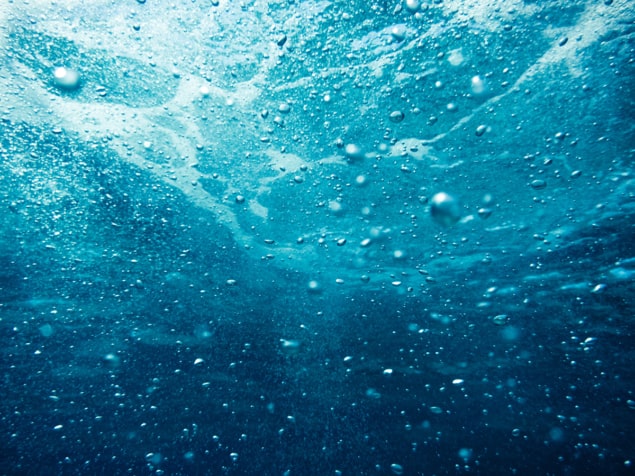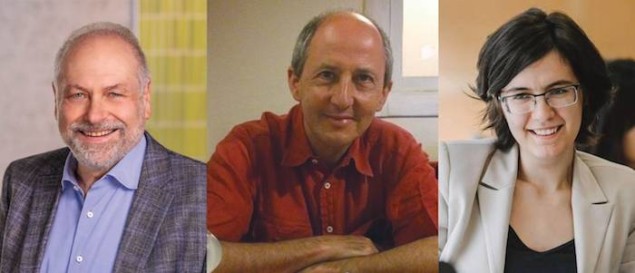
Researchers in the US and Italy have identified a second critical point in two realistic theoretical models of water. This finding, which draws on state-of-the-art computational methods and supports a hypothesis first put forward more than 25 years ago, suggests that water exists in two distinct liquid phases, one of which is less dense and more structured than the other.
The central role of water in life as we know it makes it easy to forget just how unusual it is. Unlike most other liquids, water is denser at ambient pressure than the ice it forms when it freezes. It also exhibits negative thermal expansion (meaning that it expands on cooling, rather than contracting), becomes less viscous when compressed and boasts no fewer than 17 crystalline phases.
But the list of oddities doesn’t end there. In 1976, Austen Angell and Robin Speedy discovered that water’s behaviour becomes even more atypical when it is cooled below its freezing point while remaining in liquid form – a “supercooled” state that occurs naturally in high-altitude clouds. Then, in 1992, a computational study by Peter Poole and colleagues at Boston University in the US suggested an even more tantalizing possibility. According to their simulations, supercooled water undergoes an additional phase transition between two liquid phases, with a liquid-liquid critical point (LLCP) occurring at pressures 2000 times higher than atmospheric pressure at sea level.
“The presence of the critical point provides a very simple explanation for water’s oddities,” says Pablo Debenedetti, a professor of chemical and biological engineering at Princeton University. For this reason, he adds, “the finding of the critical point is equivalent to finding a good, simple explanation for the many things that make water odd, especially at low temperatures.”
Seeking definitive proof
Since 1992, scientists have garnered much evidence to support the existence of an LLCP and an associated liquid-liquid phase transition (LLPT). However, no-one has yet produced definitive experimental proof, and computational research has been hampered by the extreme difficulty of performing calculations on water’s behaviour at deeply supercooled temperatures. Indeed, previous computational studies have only found evidence for an LLPT in the so-called “ST2” model of water, which does not fully capture the material’s characteristic geometric structure (which is tetrahedral, with four water molecules clustered around a fifth in the centre).
Debenedetti and colleagues Gül Zerze at Princeton and Francesco Sciortino of the Sapienza University of Rome have now observed LLCP behaviour in two models of water, TIP4P/2005 and TIP4P/Ice, that are far more realistic. To do this, they performed molecular dynamics simulations lasting tens of microseconds – a long time, given the large number of molecules being simulated (300 in one experiment) – and used the results to collect statistics on the density of liquid water and its thermodynamic energy fluctuations. They then used statistical mechanics to predict the behaviour of these density and energy fluctuations across a range of temperatures and pressures. Finally, they fit the statistics of the fluctuations to theoretical predictions made using the 3D Ising model of magnetism, which can be used to describe the behaviour of fluids close to their ordinary vapour-liquid critical point.

From this constrained fit, the researchers obtained values of water’s critical temperature and pressure. They also computed a quantity called the static structure factor, which relates to the way the density of a fluid varies as a function of distance from a central molecule – something that Debenedetti notes can also be measured experimentally, for example with X-ray scattering.
The Princeton team extract two quantities from this information: water’s isothermal compressibility, which quantifies how sensitive its density is to changes in pressure; and its correlation length, which quantifies the distance over which density fluctuations are correlated. Both quantities become infinite at a critical point, and the dramatic growth in their numerical value leading up to that point is expected to follow precise mathematical expressions, Debenedetti explains.
“We observed a very pronounced growth in the compressibility and the correlation length for both of the water models we studied,” he says. From the form of this growth, he adds, he and his colleagues were able to locate the hypothesized second critical point at around 170 K in one model and 190 K in the other.
Consistent values
Debenedetti says that the results of their simulations are consistent with pronounced density fluctuations occurring on all length scales close to the critical point. Such behaviour is characteristic of the 3D Ising “universality class”, where a universality class is the collection of models (or actual experimental systems) that exhibit the same scale-invariant behaviour near a critical point. Since the behaviour of fluids close to their ordinary vapour-liquid critical point shows similarities with the 3D Ising model of magnetism, the growth of the correlation length close to this new liquid-liquid critical point should obey the same mathematical equation: a power law with the same, universal exponents. “We have now observed this behaviour close to the liquid-liquid critical point in the TIP4P/2005 and TIP4P/Ice models of water,” he tells Physics World.

Supercooled water could exist in two liquid phases
The difference between the two liquid phases observed in the model is subtle but important, Debenedetti says. Whereas the local arrangement of molecules around a given water molecule is tetrahedral in the low-density liquid phase, in the high-density phase a sixth molecule squeezes in to disrupt this arrangement.
Alternative computational approaches
Debenedetti stresses that actual verification (or otherwise) of a second critical point in real water must come from experiments, not just simulations. He and his colleagues, who report their work in Science, hope their work will further motivate experimentalists’ quest to prove or disprove its existence. “For our part, we are now investigating even better models,” he adds. “We are particularly interested in machine-learning-based approaches that combine quantum-level accuracy while avoiding the high computational cost associated with explicit quantum calculations.”



